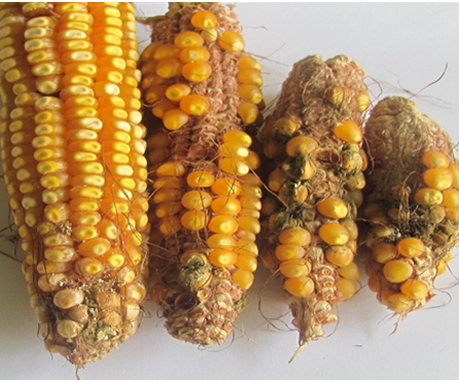Biological Methods of Controlling Aflatoxins
 By Dr. Abigael Ouko (PhD in Genetics),
By Dr. Abigael Ouko (PhD in Genetics),
University of Nairobi
Research Area
● Genetics of fungal metabolites in plants and animal products
● Capacity building in food safety and genetics
● Promoting sustainable land use and biodiversity through improving production of indigenous crop varieties and animal husbandry
Moulds (fungi) are soft, green or grey growth that develops on food or objects that have been left for too long in the warm, wet air. They occur naturally in the soil/air and infect crops grown in the field such as maize, peanuts, beans, cotton among others. Actually, moulds can grow on anything. They produce poisons which accumulate in the infected crop for example in the maize kernels.


Aflatoxin is an example of such poisons produced by fungus called Aspergillus flavus. Continuous consumption of food(s) containing such poison in our food is known to cause liver cancer, throat cancer among others. No wonder we experience sudden rise in cancer cases especially in the third world countries where regulation of consumption of poison in food is not observed (Okoth, 2016). Human deaths due to consumption of the poison have been reported in Kenya yearly since 1981 and deaths have also occurred in other animals. Traditional control measures such as early planting, good farm management practices, proper drying of seeds after harvesting and good storage methods have been used to control the fungus. Trials are also underway in the aflatoxin ‘hot’ zones in Kenya, involving the use of ‘good fungus’ to control fungus producing poison. However, there is higher possibility of the good fungus mating with the aflatoxin producing fungus leading to production of a new generation of superior aflatoxin producing fungus and aggressive colonizers as discussed in Ouko et al, 2018. This possibly could increase the burden of aflatoxin exposure in food.
I acknowledge research and trials that are ongoing in Kenya involving the use of good fungus to control the aflatoxin producing fungus even though am not in agreement, I think before such control measures are widely implemented, the fungus in the soils from the trial areas should be tested for their mating patterns. This will enable selection of the good fungus that lacks aflatoxin cluster genes since it might be more difficult to inherit the entire bunch of genes after mating. I hope the government, policy makers and my fellow research scientists consider the future of aflatoxin burden in Kenya before such control measures are fully instigated

